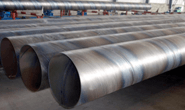Trade Cases

ITA Finds Evasion of P&T Duties Via Vietnam in Final Ruling
Written by Laura Miller
November 10, 2023
A US government agency announced this week that certain welded steel pipe and tube products being exported from Vietnam to the US have, in fact, been illegally evading the payment of import duties.
The US Department of Commerce’s International Trade Administration (ITA) issued its final rulings in a handful of investigations examining the circumvention of antidumping and countervailing duties (AD/CVDs). The notices were posted in the US government’s Federal Register.
These final rulings by the ITA were unchanged from its preliminary findings issued earlier this year.
The department found that Vietnam has been shipping to the US welded pipe and tube products that were completed using hot-rolled substrate from other Asian countries. This allowed companies to skirt paying the AD and CVDs on pipe and tube from those countries. This is illegal per US trade law.
The ITA ruled that duties are being circumvented on light-walled rectangular tubing from China, Taiwan, and South Korea. The agency said that duties on welded carbon pipe from China, welded standard pipe from India, and welded non-alloy pipe from Korea are also being illegally circumvented.
As a result of the ITA’s affirmative final determinations, imports of the pipe and tube products will now be subject to AD rates of 85.55-255.07% and CVD rates of 15.28-39.01%. These are the margins currently used for Chinese-origin products and are higher than many of the rates the companies initially tried to avoid paying. This penalty is to discourage and “to prevent evasion,” the ITA explained in its final rulings.
The duties will be applied to any of the subject products that entered the country after Aug. 4, 2022. That’s the date the start of the investigations were announced by the ITA in the Federal Register.
The duty circumvention inquiries were opened last year at the request of the United Steelworkers (USW) union and US pipe and tube producers Atlas Tube, Bull Moose Tube, Maruichi American Corp., Nucor Tubular Products, Searing Industries, Vest Inc., and Wheatland Tube.

Laura Miller
Read more from Laura MillerLatest in Trade Cases

SMU Survey: Less support seen for Trump tariff policies
Meanwhile, an increasing number think it's too early to say whether the penalties are going to bring more manufacturing to the US.

CRU: USW seeks exclusion for Canada from Trump’s tariffs
The union is also urging stronger enforcement against countries such as China which break trade rules, and a coordinated Canada-US strategy to protect union jobs across the North America

Price on trade: A lot happened last week – and it wasn’t all about tariffs
Should foreign investment be allowed to reshape the American steel Industry? Not to be lost in the recent on-again-off-again tariff frenzy, Nippon Steel’s proposed takeover of U.S. Steel has also found itself in President Trump’s crosshairs when it comes to trade and industrial policy. Nippon Steel initially announced its nearly $15-billion bid for U.S. Steel […]

Trump signs executive order aimed at making US shipbuilding ‘great again’
President Trump on Wednesday signed an executive order meant to breathe new life into American shipbuilding and curb Chinese dominance in the sector.

Trump still against selling USS to Japanese firm: Report
Despite ordering a new review of Nippon Steel’s bid for U.S. Steel, President Trump said he is still against selling USS to a Japanese company, according to media reports.
